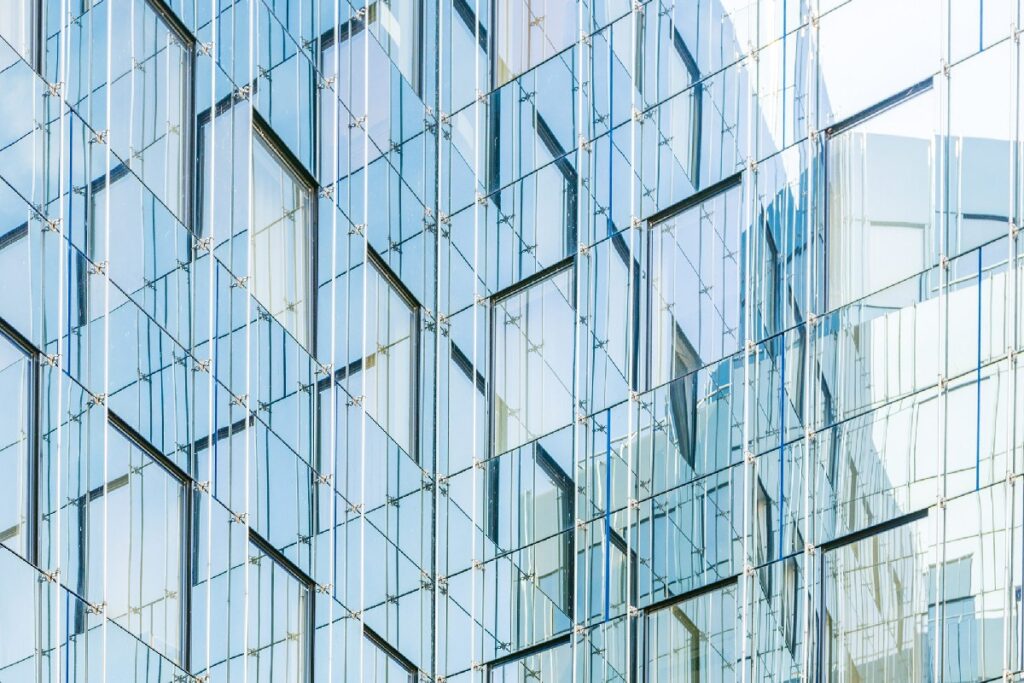Skilled, efficient, and creative building designs define modern architecture; curtainwalling is therefore very important in determining this aesthetic appeal. Whether you\’re thinking about high-performance facades for a business project or appreciating the glass-covered buildings in a metropolitan city, curtainwalling is the secret to a gorgeous but useful exterior.
But just precisely what is curtainwalling? How does it go, and why are contemporary structures choosing this option? Including its varieties, materials, advantages, technical details—such as the aluminium curtain wall frame and curtainwall profile—this guide will lead you through all you need to know about curtain walling.
What is Curtainwalling?
Modern buildings utilize non-structural outside coverings called curtainwalling to increase energy efficiency, shield against weather, and improve appearance. Whereas load-bearing walls support the structural integrity of the building, curtain walls serve as a protective skin layer fastened to the main frame.
Usually composed of glass, aluminium, or composite panels, curtain walls provide tall buildings with lightweight solutions together with great insulation, durability, and architectural freedom.
Curtainwalling System Types
Two main kinds of curtain walling exist:
Stick System Curtain Wall System
- Compiled on-site, piece by piece.
- Provides more design modification freedom.
- Takes additional installation time but is reasonably affordable.
Unitized Curtain System
- Made off-site, then assembled on-site, prefabricated panels
- Quicker installation speed helps to lower labour expenses and time needed.
- Guarantees more control and accuracy.
Advanced aluminium curtainwall frames and curtainwall profiles allow both systems to guarantee architectural appeal, durability, and efficiency.
Materials Used in CurtainWalling
Different materials are used to create curtain walls based on design criteria, insulation needs, and budget concerns.
- Aluminium: Because of its lightweight, corrosion-resistant strength, curtain walling most often uses this material. A standard choice for strong yet attractive facades is an aluminium curtainwall frame.
- Glass: Improves natural light transmission while being sleek and contemporary. High-performance glass reduces noise, offers thermal insulation and UV protection.
- Panel Composite: Made of polymer, steel, or aluminium layers, these panels provide exceptional weatherproofing and fire resistance.
- Steel: Less prevalent yet utilised for applications calling for additional strength and longevity. Important Uses for CurtainWalling.
Benefits of Curtainwalling
Beyond looks, installing a curtainwalling system has many benefits:
- Improved Visual Appealing: Modern structures give sleek, modern exteriors top priority, and curtain walling gives the whole architectural style a flawless, polished look.
- Sustainability and Energy Efficiency: Particularly those including double-glazed glass, curtain walling systems help to improve thermal insulation and lower heat loss. Excellent energy efficiency guaranteed by a high-performance curtainwall profile results in reduced heating and cooling costs.
- Durability & Weather Resistance: Shields constructions from UV, rain, and wind. Modern aluminium curtain walls provide a lifetime without sacrificing weight.
- Enhanced Natural Light: More daylight can enter glass curtain walls, therefore lowering the demand for artificial lighting and improving the inside conditions.
- Strong Yet Lightweight Structure:Curtainwalling is lightweight, so lowering the total structural load of the construction unlike brick or concrete walls. This guarantees improved seismic performance, so strengthening buildings.
Understanding Aluminium Curtainwall Frame
Popular for its strength, adaptability, and lightweight qualities, the aluminium curtainwall frame maintains a sleek, modern appearance. This frame accommodates glass panels or other facade materials.
The aluminium curtainwall frame has a high strength-to-weight ratio for greater structural performance; corrosion-resistant for long-term durability; little maintenance with a sleek, modern finish; compatible with energy-efficient glazing for improved insulation. Commercial high-rises, offices, and shopping centres all make extensive use of this kind of frame.
Investigating Curtainwall Profile Technical Information
The curtainwall profile is a great substitute for buildings needing small yet effective curtain walling solutions.
The curtainwall profiles\’ key specifications are:
- Smaller profile width for a sleek, minimalistic design;
- Optimised thermal insulation to lower energy consumption;
- Enhanced wind resistance and weatherproofing;
- Great compatibility with many glazing systems.
- Smaller commercial developments, mid-rise buildings, and contemporary homes all fit this profile.
Curtainwalling is a high-performance facade solution with modern aesthetics, energy efficiency, and longevity that goes beyond mere architectural trends. The appropriate solution will improve the attractiveness and efficiency of your building, whether you choose a curtainwall profile for a modern office space or an aluminium curtainwall frame for a big commercial skyscraper. Forward-looking builders, designers, and engineers still choose curtain walling as their preferred option as the need for creative and environmentally friendly construction rises. Seeking superior curtain walling solutions? Modern designs catered to your requirements come from Koemmerling Aluminium.
FAQ’s
- Is curtainwalling only for business constructions?
Not at all. Although commercial skyscrapers most often include curtain walling, its energy efficiency and elegant appearance are driving popularity in high-end homes and mid-rise buildings.
- Curtainwalling calls for how much maintenance?
Compared to conventional facades, curtainwalling requires little maintenance. Constant cleaning of glass panels and sporadic frame inspections guarantee a lifetime. Because of their corrosion resistance, aluminium frames require especially little maintenance.

